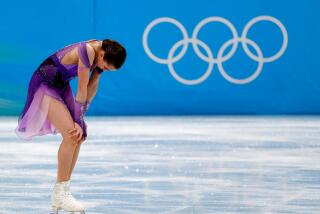Doping Case Ends on Mistake
- Share via
Despite failing a test for blood doping, U.S. cyclist Tyler Hamilton will keep the gold medal he won at the Athens Olympic Games because of a laboratory mistake, Olympic and anti-doping authorities said Thursday.
But in a turn that raises further questions, Hamilton’s cycling team confirmed Thursday that both the initial and back-up tests on a blood sample provided by the cyclist at a race in Spain shortly after the Games were positive for doping, allegedly showing evidence of someone else’s blood in his system.
Hamilton, 33, of Marblehead, Mass., said in a statement released Thursday on his team’s website, “I will prove my innocence.”
Hamilton’s victory in Athens on Aug. 18 made him the first American to win the individual time trial, a 29.8-mile race, in a non-boycotted Olympics. After years of toiling in the shadow of U.S. cycling icon Lance Armstrong, most notably in the Tour de France, the Games gave Hamilton worldwide acclaim.
Now Hamilton is in limbo, and Olympic and anti-doping authorities, who have embarked upon an aggressive campaign to blunt doping in sport, must confront a setback rooted in a simple error.
In Athens, instead of properly refrigerating a sample of Hamilton’s blood at 39 degrees after performing an initial test on it, a laboratory inexplicably froze it.
The International Olympic Committee notified Hamilton in a letter dated Sept. 16 that the initial test had revealed “two different red blood cell populations” -- his, and someone else’s.
But freezing that sample -- down to about 5 degrees below zero -- destroyed it, the IOC’s anti-doping chief, Arne Ljungqvist of Sweden, said in a conference call with reporters.
“Human error occurs,” he said.
Blood doping has been a long-standing Olympic concern, particularly among athletes in sports requiring endurance, such as cycling in the Summer Games and cross-country skiing in the Winter Olympics. The idea is to get more oxygen to the muscles, which enables them to work harder.
One way to do that: a transfusion, which introduces someone else’s blood into an athlete’s system, increasing the number of oxygen-carrying red blood cells.
An athlete’s sample, blood or urine, is typically split into two parts, one for immediate analysis, the second to confirm -- or raise doubt -- about the first if it shows evidence of doping. The first part is called the A sample, the second the B.
It remains unclear how Hamilton’s B sample was mistakenly frozen.
Costas Georgakopoulos, the director of the Athens lab, did not respond to a message left late Thursday on his mobile phone.
The Athens Games produced a record 24 doping cases; the figure includes positive cases and rules violations such as failing to appear for a doping test. Hamilton’s positive sample threatened to make him the first American to be formally accused of a doping violation at the 2004 Games.
The IOC, in a statement released Thursday, said it would not pursue sanctions linked to Hamilton’s Athens test. However, it also noted “the fact that the analysis of the B sample was not conclusive does not challenge the accuracy of the A sample.”
The tests performed in Spain are from a blood sample Hamilton submitted on Sept. 11 at an event called the Spanish Vuelta. If a doping violation is confirmed, Hamilton typically would draw a two-year ban.
Hamilton’s cycling team, Swiss-based Phonak, announced he is suspended -- but not fired.
“Certainly we need to look pretty closely at the test and at the results from the Vuelta,” said Hamilton’s attorney, Howard Jacobs of Westlake Village.
During the Athens Games, the IOC for the first time performed tests on certain blood samples searching for evidence of transfusions. Also for the first time, it tested for human growth hormone and performed certain other blood tests.
Medical director Patrick Schamasch said the IOC performed 382 blood tests from July 30 to Aug. 29, which is 12% of the 3,123 tests overall. Hamilton’s is the only one of the 382 to have shown “adverse” findings, Ljungqvist said.
The newness of the blood-testing procedures may have contributed to the mistake, officials said Thursday.
Ljungqvist said he didn’t realize the sample had been frozen until he had returned to Sweden after the Games. By that time, the sample had been on ice for several days.
Blood transfusions were an issue at the 1984 Olympics in Los Angeles, when two out of eight U.S. cyclists who had injected themselves with blood became ill. The next year, spurred by the ethical and medical risks of transfusion, the IOC banned what was termed “blood doping.”
After that, blood transfusion seemed to lose favor as a method of enhancing athletic performance. Instead, athletes tempted to cheat often turned to a synthetic blood booster, erythropoietin, or EPO, developed to treat anemia and other medical ills. It increases the percentage of oxygen-carrying red blood cells in the system.
But that was thwarted by authorities who developed tests to detect EPO and its chemical cousins, including a substance called darbepoetin.
Olympic and anti-doping experts said this week that some athletes have gone back to using transfusions, a threat underscored at the close of the 2002 Salt Lake City Winter Olympics by the discovery of transfusion equipment at a house used during the Games by some Austrian skiers.
After an extensive inquiry, the IOC imposed sanctions on two Austrian cross-country skiers, their coach and a chiropractor.
Readying for the 2004 Summer Games, anti-doping authorities approved an Australian test designed to detect the presence of what scientists call different blood “populations” in an athlete’s system.
Phonak, the cycling team, said it intends to arrange for a scientific panel to study the reliability of the blood tests.
Jacobs, Hamilton’s attorney, said, “Given that it’s a brand-new test, it raises serious questions about the validity of the test itself as well as possibly the accuracy of how the test was implemented.”
Anti-doping and Olympic officials, however, said the test is fair and accurate and was subjected to appropriate scientific review before it was implemented.
The World Anti-Doping Agency, based in Montreal, has “complete confidence in the test,” its president, Dick Pound, a longtime IOC member, said Thursday in a telephone interview.
Ljungqvist said, “The outcome of [Hamilton’s] B analysis has nothing to do with the method. It’s simply because this sample was, unfortunately, destroyed and couldn’t be analyzed.”
More to Read
Go beyond the scoreboard
Get the latest on L.A.'s teams in the daily Sports Report newsletter.
You may occasionally receive promotional content from the Los Angeles Times.






